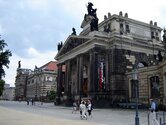Bruehl’s Terrace - Dresden's balcony with an unique Elbe river view
Brühl’s Terrace is a horticultural treasure of a special kind. The terrace owes its name to count Heinrich von Brühl (1700 – 1763), then cabinet minister of Friedrich August II. (1797 – 1854). Brühl’s Terrace got gradually its current appearance above all by numerous building alterations at the end of the nineteenth century, and the filling of the terrace bank. Thus the terrace is with its unique ensemble consisting of horticulture and architecture one of the primary trails to take a stroll in the town on the river Elbe, because the nickname “The Balcony of Europe” from the early nineteenth century holds true for today. Among other things Brühl’s Terrace is framed by the Academy of Fine Arts (Kunstakademie), the Sächsisches Ständehaus (today housing Saxony’s Supreme Court), the Sekundogenitur, and the Albertinum. Likewise there are historical evidences of time under the terrace that are often ignored besides the baroque highlights.
Monument for Johann Friedrich Boettger (Boettger-Gedenkstele)
Until the explosion of the powder magazine in 1747 under the terraces there were the vaults, in which Johann Friedrich Boettger (1682 – 1719) and Ehrenfried Walther von Tschirnhaus (1651 – 1708) developed at the end of the year 1707 the procedure for the production of the European hard porcelain. Boettger’s „Melting Kitchen“ in the casemates of the Venus Bastion (Jungfernbastei) is seen as the cradle of European porcelain and the first European porcelain manufacture, too.
Basement Vault (Baerenzwinger)
With its yard surrounded by high walls and an old barrel vault the Basement Vault is the only casemate entrance of Brühl’s Terrace that survived. Since 1968 the student club with the same name is located here. Sometimes guests in our vacation homes in Dresden get lost in that restaurant.
Dresden Fortress . Dresden Experience
Straight under Brühl’s Terrace preserved parts of a former imposing fortification are situated – the Dresden Fortress. On the 30.11.2019 the fortress Dresden reopened with the exhibition "festivals, dramas, catastrophes" and is considered one of the most modern museums in Europe, maybe in the world.
New Synagogue
To the east of the Brühl Garden the new synagogue was constructed between 2000 and 2002 financed by donations. It was not reerected according to the construction plans of Semper in its old shape, which was destroyed in the Kristallnacht in 1938, but built in modern style and won many architectural awards.
Albertinum
King Albert of Saxony (1828 - 1902) was builder-owner and name giver of this in 1887 completely finished building. Prior to this the electoral arsenal in Renaissance-style stood in the same place. But it had to make way for the Albertinum. Today the building with a sandstone façade in the style of Italian High Renaissance hosts the New Masters Gallery (Galerie Neue Meister). In 2010 this building and the exhibition was reopened.
Academy Of Fine Arts (Kunstakademie)
The huge building of the Academy of Fine Arts was constructed between 1891 and 1895 and is lyceum for sculpture, architecture and painting. The Academy together with the attached exhibition building appears monumentally and opulently. This is also to emphasise that Dresden is one of the leading art and culture cities in Europe. The out of scale appearing windows serve for good lighting conditions of the numerous artist’s workshops of the there located College of Visual Arts.
Sekundogenitur
This small building in a smiling style of neo-Baroque was finished in 1897 as a library and a location for the copper engraving collection (Kupferstichsammlung). In the bombing of February 1945 the Sekundogenitur burned out completely. The rebuilt house has been using by restaurateurs since 1964.
Staendehaus
For the construction of the Ständehaus valuable baroque building fabric was pulled down in 1899: the Palace Fürstenberg and the Brühl Palace. Master builder Paul Wallot (1841 - 1912, among other things architect of the 1892 constructed Berlin Reichstag) put in all his craftsmanship to keep with the Ständehaus the proportions of the buildings at the Schlossplatz. With the first meeting of the Saxon Parliament on 14th October 1907 the house served its purpose for the first time. Today Saxony’s Supreme Court resides in the Ständehaus.



























